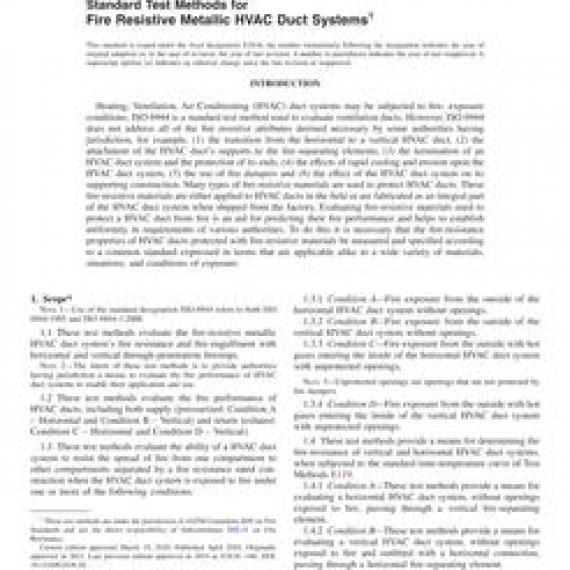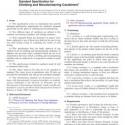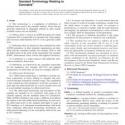No products
ASTM E2816-20
ASTM E2816-20 Standard Test Methods for Fire Resistive Metallic HVAC Duct Systems
standard by ASTM International, 03/15/2020
Full Description
Note 1:Use of the standard designation ISO 6944 refers to both ISO 6944:1985 and ISO 6944-1:2008.
1.1These test methods evaluate the fire-resistive metallic HVAC duct systems fire resistance and fire-engulfment with horizontal and vertical through-penetration firestops.
Note 2:The intent of these test methods is to provide authorities having jurisdiction a means to evaluate the fire performance of HVAC duct systems to enable their application and use.
1.2These test methods evaluate the fire performance of HVAC ducts, including both supply (pressurized: Condition A - Horizontal and Condition B - Vertical) and return (exhaust: Condition C - Horizontal and Condition D - Vertical).
1.3These test methods evaluate the ability of a HVAC duct system to resist the spread of fire from one compartment to other compartments separated by a fire resistance rated construction when the HVAC duct system is exposed to fire under one or more of the following conditions:
1.3.1Condition A-Fire exposure from the outside of the horizontal HVAC duct system without openings,
1.3.2Condition B-Fire exposure from the outside of the vertical HVAC duct system without openings,
1.3.3Condition C-Fire exposure from the outside with hot gases entering the inside of the horizontal HVAC duct system with unprotected openings,
Note 3:Unprotected openings are openings that are not protected by fire dampers.
1.3.4Condition D-Fire exposure from the outside with hot gases entering the inside of the vertical HVAC duct system with unprotected openings.
1.4These test methods provide a means for determining the fire-resistance of vertical and horizontal HVAC duct systems, when subjected to the standard time-temperature curve of Test Methods E119.
1.4.1Condition A-These test methods provide a means for evaluating a horizontal HVAC duct system, without openings exposed to fire, passing through a vertical fire-separating element.
1.4.2Condition B-These test methods provide a means for evaluating a vertical HVAC duct system, without openings exposed to fire and outfitted with a horizontal connection, passing through a horizontal fire-separating element.
1.4.3Condition C-These test methods provide a means for evaluating a horizontal HVAC duct system, with unprotected openings exposed to fire, passing through a vertical fire-separating element.
1.4.4Condition D-These test methods provide a means for evaluating a vertical HVAC duct system with a horizontal connection, and with unprotected openings exposed to fire, passing through a horizontal fire-separating element.
1.5These test methods prescribe a standardized fire exposure for comparing the test results of the fire resistive materials and HVAC duct systems. The results of these tests are one factor in assessing predicted fire performance of HVAC duct systems. Using these test results to predict the performance of actual HVAC duct systems requires the evaluation of test conditions.
1.6The values stated in inch-pound units are to be regarded as the standard. The SI values given in parentheses are for information only, unless the SI units are used consistently to perform all of the test methods referenced herein. In this case, the SI units will be regarded as the standard and will be used in Section 13, Report.
1.7The text of these test methods references notes and footnotes which provide explanatory material and (excluding those in tables and figures) shall not be considered as requirements of the fire-test-response standard.
1.8This document specifically excludes evaluating ducts that carry combustibles, flammable vapors, combustible gases, and commercial kitchen ventilation systems commonly called grease ducts or hazardous exhaust ducts, which are tested in compliance with Test Methods E2336.
1.9This standard is used to measure and describe the response of materials, products, or assemblies to heat and flame under controlled conditions, but does not by itself incorporate all factors required for fire hazard or fire risk assessment of the materials, products, or assemblies under actual fire conditions.
1.10This standard does not purport to address all of the safety concerns, if any, associated with its use. It is the responsibility of the user of this standard to establish appropriate safety, health, and environmental practices and determine the applicability of regulatory limitations prior to use.
1.11Fire testing is inherently hazardous. Adequate safeguards for personnel and property shall be employed in conducting these tests.
1.12This international standard was developed in accordance with internationally recognized principles on standardization established in the Decision on Principles for the Development of International Standards, Guides and Recommendations issued by the World Trade Organization Technical Barriers to Trade (TBT) Committee.


































